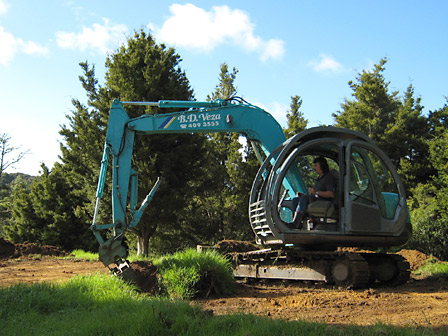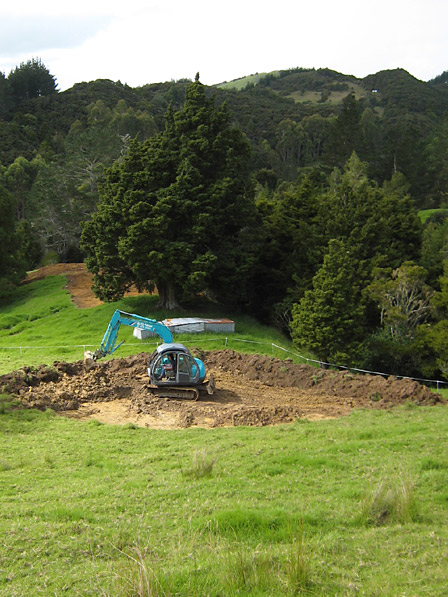One fine morning last week, a big truck with a digger perched on the back came rumbling up our driveway. Kevin and I went running out to meet the driver. We had arranged for the digger to come and level a site for the proposed milking shed, as well as dig out a dam on our hillside. This was the big day!

Barry goes right to work on the milking shed site
As the digger went to work, we stood together on the side of the hill, mesmerised. Kevin commented that the digger had moved more earth in five minutes than he had moved in his whole life. Quite humbling! We watched the digger undertake work that would (I imagine) take the two of us (with shovels) the rest of our lives. It was finished by 4 in the afternoon! This exercise has made us ponder anew the wonders that our “petrochemical slaves” can accomplish for us. With this project, we feel we have made prudent use of available petrochemical power to establish water security and farm infrastructure that should serve us well for many years to come.

Shed site

Inset ‘shelf’ for water tank; sandstone and very hard clay
Just below the site for the shed, the digger cut out another smaller level site. This will be for a large water tank to store rainwater harvested from the shed roof. We will use a gravity-feed system to bring this water down to the house for domestic use. The dam will be for irrigation and stock watering. We already have a gravity-feed system coming from a spring on a neighbour’s property. This has been sufficient for our needs so far, but would not be enough for irrigating trees and garden during a dry summer. We are aiming to create a water system with multiple redundancies, so that in the future we will never need to worry about a lack of water on the Farmlet.
The cows looked very curious to see the digger in their paddock. Esmerelda looked taken aback to see something (something bigger and louder than her!) chewing up her hillside. After a while, their curiosity got the better of them. When the digger driver stopped for lunch, three cows wandered over to check out the new terrain. . . and to rub their heads in the fresh dirt. They all got very grubby, and had to be shooed away so that the digging could continue! The animals are now fenced out of the dam area, and this is the way it will stay! After all that work, we don’t want them turning the area into a horrible, boggy mess.

A creature larger than Esmerelda?!

Looking down on the dam area
Erosion has been (and still is) a major concern with all this work. We asked around to find a digger operator with an excellent reputation for building stable dams. My aunt and uncle recommended Barry, and so far we have been very impressed with his work. We asked him to keep the topsoil separate from the subsoil as much as possible, and spread it over the top of the open areas so that it will be easier to re-establish ground cover. We have already mulched part of the dam walls, and have sown lupins and mustard for cover. Eventually, we hope to plant mat-rooted plants (like New Zealand flax) on the dam walls. We also hope to plant other trees and plants, in order to create a special micro-climate around the dam.

Finished and ready
Water storage dams need to be deep in order to work well, but I had hoped we could have a shelf of shallower water around one side of the dam. This was to be an area for various aquatic plants that grow well in shallow water. Barry was about to cut out the ledge, when he realised that the shallow area would be very hard to reach (for planting, cultivation, and harvesting) due to the height of the dam walls relative to the overflow. So, we ended up scratching this aspect of the plan. I’m disappointed, but hoping we can still cultivate a variety of floating aquatic plants in the dam.
Now we are planning a trip to the hardware store (probably the day after tomorrow) to sort out materials for the shed. Busy times are ahead! We are hoping the weather stays dry for a while, so that we have a better chance to get the building supplies up the hill. Of course, we are also eager to see how the dam will handle its first decent shower of rain.
